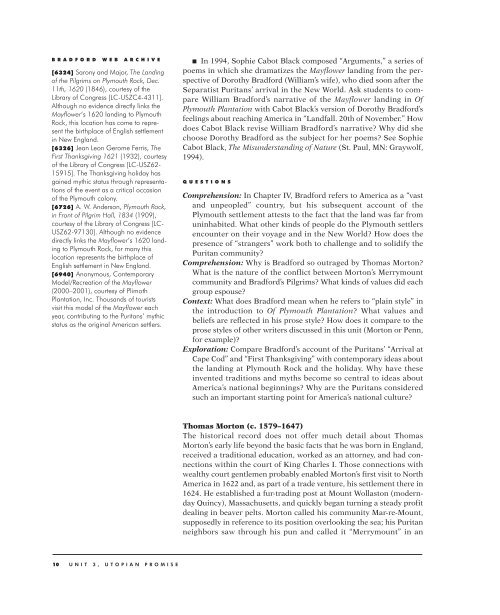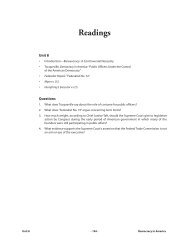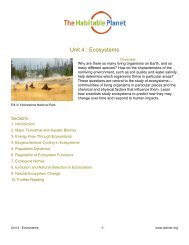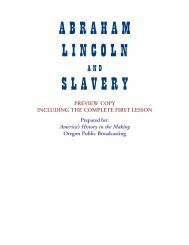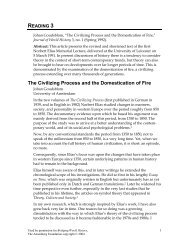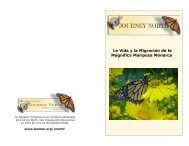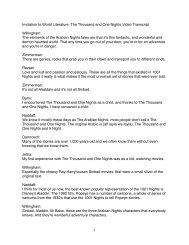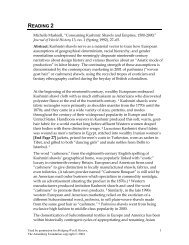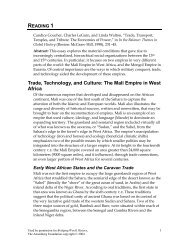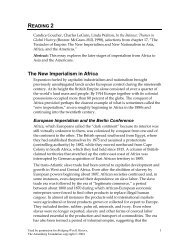UTOPIAN PROMISE - Annenberg Media
UTOPIAN PROMISE - Annenberg Media
UTOPIAN PROMISE - Annenberg Media
Create successful ePaper yourself
Turn your PDF publications into a flip-book with our unique Google optimized e-Paper software.
BRADFORD WEB ARCHIVE<br />
[6324] Sarony and Major, The Landing<br />
of the Pilgrims on Plymouth Rock, Dec.<br />
11th, 1620 (1846), courtesy of the<br />
Library of Congress [LC-USZC4-4311].<br />
Although no evidence directly links the<br />
Mayflower’s 1620 landing to Plymouth<br />
Rock, this location has come to represent<br />
the birthplace of English settlement<br />
in New England.<br />
[6326] Jean Leon Gerome Ferris, The<br />
First Thanksgiving 1621 (1932), courtesy<br />
of the Library of Congress [LC-USZ62-<br />
15915]. The Thanksgiving holiday has<br />
gained mythic status through representations<br />
of the event as a critical occasion<br />
of the Plymouth colony.<br />
[6726] A. W. Anderson, Plymouth Rock,<br />
in Front of Pilgrim Hall, 1834 (1909),<br />
courtesy of the Library of Congress [LC-<br />
USZ62-97130]. Although no evidence<br />
directly links the Mayflower’s 1620 landing<br />
to Plymouth Rock, for many this<br />
location represents the birthplace of<br />
English settlement in New England.<br />
[6940] Anonymous, Contemporary<br />
Model/Recreation of the Mayflower<br />
(2000–2001), courtesy of Plimoth<br />
Plantation, Inc. Thousands of tourists<br />
visit this model of the Mayflower each<br />
year, contributing to the Puritans’ mythic<br />
status as the original American settlers.<br />
10 UNIT 3, <strong>UTOPIAN</strong> <strong>PROMISE</strong><br />
■ In 1994, Sophie Cabot Black composed “Arguments,” a series of<br />
poems in which she dramatizes the Mayflower landing from the perspective<br />
of Dorothy Bradford (William’s wife), who died soon after the<br />
Separatist Puritans’ arrival in the New World. Ask students to compare<br />
William Bradford’s narrative of the Mayflower landing in Of<br />
Plymouth Plantation with Cabot Black’s version of Dorothy Bradford’s<br />
feelings about reaching America in “Landfall. 20th of November.” How<br />
does Cabot Black revise William Bradford’s narrative? Why did she<br />
choose Dorothy Bradford as the subject for her poems? See Sophie<br />
Cabot Black, The Misunderstanding of Nature (St. Paul, MN: Graywolf,<br />
1994).<br />
QUESTIONS<br />
Comprehension: In Chapter IV, Bradford refers to America as a “vast<br />
and unpeopled” country, but his subsequent account of the<br />
Plymouth settlement attests to the fact that the land was far from<br />
uninhabited. What other kinds of people do the Plymouth settlers<br />
encounter on their voyage and in the New World? How does the<br />
presence of “strangers” work both to challenge and to solidify the<br />
Puritan community?<br />
Comprehension: Why is Bradford so outraged by Thomas Morton?<br />
What is the nature of the conflict between Morton’s Merrymount<br />
community and Bradford’s Pilgrims? What kinds of values did each<br />
group espouse?<br />
Context: What does Bradford mean when he refers to “plain style” in<br />
the introduction to Of Plymouth Plantation? What values and<br />
beliefs are reflected in his prose style? How does it compare to the<br />
prose styles of other writers discussed in this unit (Morton or Penn,<br />
for example)?<br />
Exploration: Compare Bradford’s account of the Puritans’ “Arrival at<br />
Cape Cod” and “First Thanksgiving” with contemporary ideas about<br />
the landing at Plymouth Rock and the holiday. Why have these<br />
invented traditions and myths become so central to ideas about<br />
America’s national beginnings? Why are the Puritans considered<br />
such an important starting point for America’s national culture?<br />
Thomas Morton (c. 1579–1647)<br />
The historical record does not offer much detail about Thomas<br />
Morton’s early life beyond the basic facts that he was born in England,<br />
received a traditional education, worked as an attorney, and had connections<br />
within the court of King Charles I. Those connections with<br />
wealthy court gentlemen probably enabled Morton’s first visit to North<br />
America in 1622 and, as part of a trade venture, his settlement there in<br />
1624. He established a fur-trading post at Mount Wollaston (modernday<br />
Quincy), Massachusetts, and quickly began turning a steady profit<br />
dealing in beaver pelts. Morton called his community Mar-re-Mount,<br />
supposedly in reference to its position overlooking the sea; his Puritan<br />
neighbors saw through his pun and called it “Merrymount” in an


